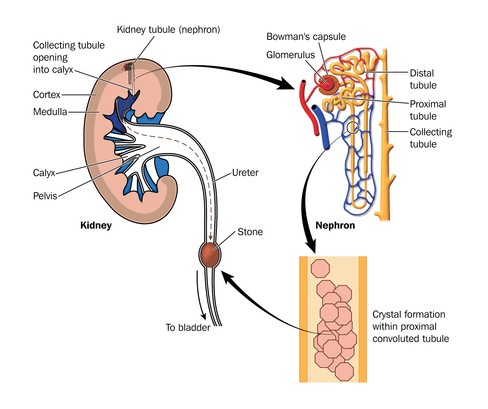 Kidney Stones
Kidney Stones
Kidney stones are an extremely common condition.
Kidney stones are solid lumps made up of tiny crystals that can develop in one or both of the kidneys. Multiple stones may be present in the kidney or ureter, the tube that leads from each of your kidneys to your bladder.
Some stones cause no symptoms at all and may pass out of the body without discomfort, or may be discovered incidentally on an X-ray during examination for another condition.
Causes of Kidney Stones
Your body will try to pass them out of the body in urine, and a stone will often travel through the urinary system. Small stones may be passed out painlessly in the urine and may even go undetected. However, it is fairly common for a stone to block part of the urinary system, such as the ureter (the tube connecting the kidney to the bladder) or the urethra (the tube through which urine passes out of the body). If this happens, it can cause severe pain in the abdomen or groin and sometimes causes a urinary tract infection.
Kidney stones are more common in men than in women and are most usually found between ages 30 and 60. Post-menopause, women become more susceptible to kidney stones.
Diet, genetic factors, work environment, and even where you live may make you more liable to kidney stones. Health conditions such as gout, recurrent urinary tract infections by certain bacteria, intestinal or bowel disease, metabolic disorders and certain medications such as diuretics can all encourage kidney stones to form.
Symptoms of Kidney Stones
The pain often starts in the abdomen or side, moving down to the groin and testicles. This may be accompanied by:
- blood in the urine
- dark or unusual coloured urine
- a frequent urge to urinate
- painful urination
- nausea, vomiting or diarrhoea
- fever and/or chills
Diagnosis of Kidney Stones
You may also need an intravenous pyelogram. Read more at Diagnostic Tests and Procedures
Treatment of Kidney Stones
Once we know the type, size and location of the stone, we will offer medical or surgical treatment accordingly.
Increasing your fluid intake and changing your diet may be the best option. You may need to drink two to three quarts of water a day in order to help the body excrete small stones in the urine.
Eating less animal protein, decreasing your salt intake, and cutting out foods high in oxalate, such as spinach, rhubarb, beets, berries, black pepper, chocolate, nuts, soy products and tea, might be the best cure and help you stay stone-free in future.
Medication may be prescribed to help balance your blood or urine.
Larger kidney stones, kidney stones that cause bleeding or infection or kidney stones blocking the flow of urine:
- The stone may be removed by Ureteroscopy, a minimally invasive, endoscopic operation where the ureteroscope is passed through the urethral opening, up through the bladder into the ureter or the kidney where the stone is located – an incision through the skin is not needed.
- Percutaneous nephrostolithotomy (PNL): special lithotriptors that fragment stones and stone removal devices are directed into the kidney via a small incision made in the patient’s back.
- Shockwave lithotripsy uses high-energy sound waves and X-rays to localize and break up smaller stones, the fragments being then passed naturally through the urinary tract.
- Laparoscopic and open surgery is occasionally necessary, and only rarely is laparoscopic kidney removal (nephrectomy) performed, if a patient has a non-functioning kidney resulting from stone disease.
Prevention of Kidney Stones
To avoid getting kidney stones it is very important to keep your urine diluted, so make sure you drink plenty of water each day.
